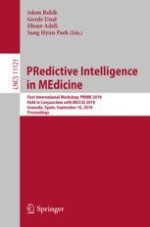2018 | OriginalPaper | Buchkapitel
Enhancement of Perivascular Spaces Using a Very Deep 3D Dense Network
verfasst von : Euijin Jung, Xiaopeng Zong, Weili Lin, Dinggang Shen, Sang Hyun Park
Erschienen in: PRedictive Intelligence in MEdicine
Aktivieren Sie unsere intelligente Suche, um passende Fachinhalte oder Patente zu finden.
Wählen Sie Textabschnitte aus um mit Künstlicher Intelligenz passenden Patente zu finden. powered by
Markieren Sie Textabschnitte, um KI-gestützt weitere passende Inhalte zu finden. powered by
